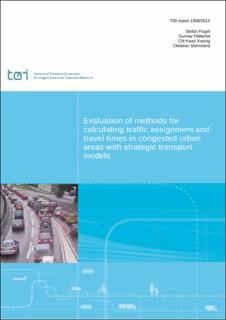| dc.contributor.author | Flügel, Stefan | |
| dc.contributor.author | Flötteröd, Gunnar | |
| dc.contributor.author | Kwong, Chi Kwan | |
| dc.contributor.author | Steinsland, Christian | |
| dc.coverage.spatial | Norway | en_US |
| dc.date.accessioned | 2020-10-06T10:27:33Z | |
| dc.date.available | 2020-10-06T10:27:33Z | |
| dc.date.issued | 2014-10 | |
| dc.identifier.uri | https://hdl.handle.net/11250/2681301 | |
| dc.description.abstract | The report evaluates methods for traffic assignment modelling
(static macroscopic, dynamic macroscopic and dynamic
micro/mesocopic) within strategic transport model systems. Our
evaluation of traffic assignment models found that dynamic
meso/micro models are most appropriate for all (considered)
application purposes in congested urban areas. The biggest
advantages are connected to the realistic modelling of
congestion and the richness in analysis (allowing to aggregate
results in any desirable way). Those models have some
practical challenges/disadvantages. They require more detailed
input data, are more demanding with respect to
implementation, calibration and usage and set high
requirements (expert knowledge) on the users. The
stochasticity of dynamic meso/micro models imply that
distributions of predictions from several model runs should be
compared. | en_US |
| dc.description.abstract | Rapporten vurderer metoder for trafikkavviklingsmodeller (statisk
makroskopisk, dynamisk makroskopisk og dynamisk
mikro/mesoskopisk) i strategiske transportmodeller. Vår evaluering
av metoder for trafikkavvikling beskriver dynamiske meso- eller
mikromodeller som mest egnet for alle (vurderte) analysehensikter i
købelastede byområder. De største fordelene er knyttet til en
realistisk modellering av kø og bredden i analysemuligheter
(muligheten til å aggregere resultater på alle ønskelige måter). Disse
modellene har imidlertid noen utfordringer/ulemper i praksis. De
krever mer detaljerte inndata, er mer krevende med hensyn på
implementering, kalibrering og bruk og stiller høyere krav
(ekspertkunnskap) på brukersiden. Pga. stokastikken i dynamiske
meso/mikro-modeller bør fordelinger av prediksjoner fra flere
modellkjøringer sammenlignes. | en_US |
| dc.description.sponsorship | Statens vegvesen | en_US |
| dc.language.iso | eng | en_US |
| dc.publisher | TØI Transportøkonomisk Institutt | en_US |
| dc.relation.ispartofseries | TØI rapport;1358/2014 | |
| dc.rights | Attribution-NoDerivatives 4.0 Internasjonal | * |
| dc.rights.uri | http://creativecommons.org/licenses/by-nd/4.0/deed.no | * |
| dc.subject | Congestion | en_US |
| dc.subject | Models | en_US |
| dc.subject | Strategic | en_US |
| dc.subject | Traffic assignment | en_US |
| dc.subject | Transport Models | en_US |
| dc.subject | Belastning | en_US |
| dc.subject | Kø | en_US |
| dc.subject | Strategi | en_US |
| dc.subject | Trafikkavvikling | en_US |
| dc.subject | Transportmodeller | en_US |
| dc.title | Evaluation of methods for calculating traffic assignment and travel times in congested urban areas with strategic transport models | en_US |
| dc.type | Report | en_US |
| dc.rights.holder | TØI Transportøkonomisk Institutt | en_US |
| dc.source.pagenumber | 82 | en_US |

